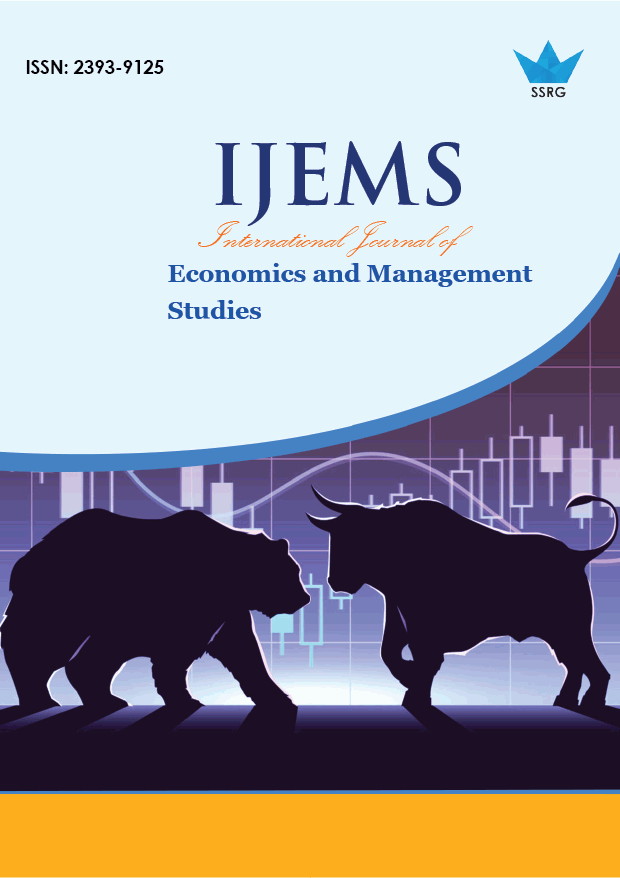A Case Study of Availability of Infrastructure for Economic Development in Himachal Pradesh

| International Journal of Economics and Management Studies |
| © 2024 by SSRG - IJEMS Journal |
| Volume 11 Issue 10 |
| Year of Publication : 2024 |
| Authors : Tanuj Sharma, Sanjeev Kumar |
How to Cite?
Tanuj Sharma, Sanjeev Kumar, "A Case Study of Availability of Infrastructure for Economic Development in Himachal Pradesh," SSRG International Journal of Economics and Management Studies, vol. 11, no. 10, pp. 21-29, 2024. Crossref, https://doi.org/10.14445/23939125/IJEMS-V11I10P103
Abstract:
Infrastructure is vital to a region’s economic development and prosperity. It supports industrial and agricultural production and foreign and domestic businesses. In the present paper, an attempt has been made to examine the availability of the infrastructural facilities for economic development in ‘Other Backward Classes’ (OBCs) sample households in the study area of Kangra, Una, Hamirpur and Sirmaur districts of Himachal Pradesh. The focus is to study the transportation facilities, electricity supply, telecommunications services, drinking water supply, sanitation, cooking fuel, and other basic facilities such as PDS (Fair price shop), Market/ Bazaar Kirana/General Market Shop, Bank Branch Office, Credit Co-operative, Post Office, School/Anganwadi, Seed/Pesticide/Fertilizer outlet in the study area. The results show that the availability of transportation services in the Una, Sirmaur, Hamirpur, and Kangra districts of Himachal Pradesh is adequate and t-statistic values indicate statistically significant differences in the availability of transportation facilities between these districts. While analyzing the data on telecommunications, sources of drinking water, sanitation, and cooking fuel among households, it was found that there are significant differences in the availability of these basic necessities in the districts of the study area. The t-statistics values indicate a high level of variability between districts, with some having much better access than others. Further results show a significant difference in the availability of essential facilities, i.e. PDS Shop, Market, Bank, School, Post Office, and Seed/Pesticide/Fertilizer Outlet in the study area. Further, it is observed that the Kangra district has the highest availability of social institutions and other facilities compared to the Una, Sirmaur, and Hamirpur districts. Overall, the data suggests that Kangra district is better equipped with essential facilities and services compared to the other districts in the study. This could have implications for the overall development and quality of life in Kangra compared to Una, Sirmaur, and Hamirpur. The significant differences in availability highlight the need for further investigation into the disparities and potential strategies for improving access to important resources in the less well-equipped districts.
Keywords:
PDS, Households, Infrastructure, t-statistics, OBCs, Tele-communication.
References:
[1] Rochana Bajpai, Redefining Equality: Social Justice in the Mandal Debate, 1990, Political Ideas in Modern India: Thematic Explorations, Sage Publications, pp. 326-339, 2006.
[Google Scholar] [Publisher Link]
[2] Carol Upadhya, “Employment, Exclusion and 'Merit' in the Indian IT Industry,” Economic and Political Weekly, vol. 42, no. 20, pp. 1863 1868, 2007.
[Google Scholar] [Publisher Link]
[3] Ashwini Deshpande, and Smriti Sharma, “Entrepreneurship or Survival? Caste and Gender of Small Business in India,” Economic and Political Weekly, vol. 48, no. 28, pp. 38-49, 2013.
[Google Scholar] [Publisher Link]
[4] Satish Deshpande, “Reservations Are Not Just About Quotas,” The Hindu, 2015.
[Google Scholar] [Publisher Link]
[5] Satish Deshpande, “Who’s Afraid of a Caste Census,” The Indian Express, 2021.
[Google Scholar] [Publisher Link]
[6] Maitreyi Bordia Das, and Puja Vasudeva Dutta, “Does Indian Caste Matter for Wages in the Indian Labour Market,” pp. 1-24, 2007.
[Google Scholar] [Publisher Link]
[7] Sandipan R. Gavhale, “Issue of Social Exclusion in India: Perspectives and Challenges,” IOSR Journal of Humanities and Social Science, vol. 22, no. 6, pp. 28-35, 2017.
[Google Scholar] [Publisher Link]
[8] Maitreesh Ghatak, India's Inequality Problem, India Forum, 2021. [Online]. Available: https://www.theindiaforum.in/article/does-india have-inequality-problem
[9] Government of India, “Report of the Backward Classes Commission,” vol. 1, pp. 1-64, 1980.
[Google Scholar] [Publisher Link]
[10] U. Oommen, and A. Meenakshisundararajan, “Social Structuring of Human Capital of the New Global Workforce,” International Conference on New Global Workforces and Virtual Workplaces: Connections, Culture, and Control, National Institute of Advanced Studies, Bangalore, pp. 12-13, 2005.
[Google Scholar]
[11] Soubhagya Ranjan Padhi, “Overcoming Exclusion and Marginalization in Education through Inclusive Approaches: Challenges and Vision of Arunachal Pradesh in India,” International Journal of Social Science and Humanity, vol. 6, no. 4, pp. 256-261, 2016.
[Google Scholar] [Publisher Link]
[12] Priyanka Pandey, and Sandeep Pandey, “Survey at an IIT Campus Shows How Caste Affects Students' Perceptions,” Economic and Political Weekly, vol. 53, no. 9, pp. 1-10, 2018.
[Google Scholar] [Publisher Link]
[13] Nirupama Pillai, “Who Are the Other Backward Classes,” National Law School of India Review, vol. 19, no. 1, pp. 31-49, 2007.
[Google Scholar] [Publisher Link]
[14] Shipra Singh, “Wealth Inequality in India Peaked during Covid,” Mint, 2022.
[Google Scholar] [Publisher Link]

 10.14445/23939125/IJEMS-V11I10P103
10.14445/23939125/IJEMS-V11I10P103